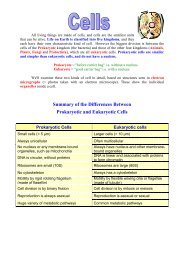Continuous and discontinuous variation - BiologyMad A-Level Biology
Continuous and discontinuous variation - BiologyMad A-Level Biology
Continuous and discontinuous variation - BiologyMad A-Level Biology
You also want an ePaper? Increase the reach of your titles
YUMPU automatically turns print PDFs into web optimized ePapers that Google loves.
Disruptive selection:<br />
This is much less common <strong>and</strong> results in two distinct<br />
populations, or morphs. Eventually, these two forms<br />
may become so distinct that they become new<br />
populations.<br />
The example usually used is Biston betularia,<br />
the Peppered Moth (left). This moth hides<br />
on birch-trees during the day, <strong>and</strong> two forms<br />
are favoured – like (clean air, pale tree-trunks)<br />
<strong>and</strong> dark (sooty air, dark tree-trunks). Any<br />
intermediate forms are obvious on any tree,<br />
<strong>and</strong> so are selected against. The dark (or<br />
melanic) form became more common in<br />
polluted city air after the Industrial<br />
Revolution, but has now become rare again,<br />
following the Clean Air Acts of the last 50<br />
years. This is usually used as an example of<br />
Natural Selection in action.<br />
Sickle-Cell Anaemia<br />
Sickle-cell is an inherited condition in which two co-dominant alleles exist – Hb S <strong>and</strong> Hb A . This<br />
condition is caused by a single point substitution mutation, resulting in a single amino-acid being<br />
changed. With 2 alleles, three phenotypes therefore exist:<br />
1.<br />
2.<br />
3.<br />
Hb S Hb S . These individuals have sickle-cell anaemia, <strong>and</strong> normally<br />
die young.<br />
Hb S Hb A . These individuals have sickle-cell trait, have only a few<br />
sickle-cells <strong>and</strong> are resistant to malaria<br />
Hb A Hb A . These individuals are normal, <strong>and</strong> are susceptible to<br />
malaria.<br />
In most parts of the world, stabilising selection selects against this mutation,<br />
so it is very rare. However, in parts of the world where malaria is<br />
common, there is a selective advantage in having sickle-cell trait. These<br />
individuals are resistant to malaria but suffer few side-effects, <strong>and</strong> can live<br />
healthy <strong>and</strong> productive lives. Normal people may well be infected with<br />
malaria <strong>and</strong> die, whilst those with sickle-cell anaemia die young. That means<br />
the population is selected for this mutation (left):<br />
Note that, with modern medicine, sickle-cell<br />
individuals can survive <strong>and</strong> reproduce, so we can<br />
now also have:<br />
© IHW April 2006
















